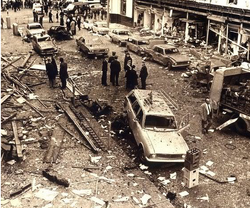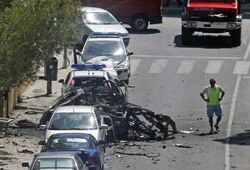Barzona Libre (Dutch: Free Brezonde, Frij Brezonde) is an armed Barzuna nationalist and separatist organization. The group was founded in 1963 and has since evolved from a group promoting traditional Barzuna culture to a paramilitary group with the goal of gaining independence for traditional Barzuna lands. Since 1973, BL has been held responsible for killing 89 individuals, injuring hundreds and undertaking many kidnappings. The group is proscribed as a terrorist organization by the Brunanter government and the European Union.
History[]
Early history[]
Barzona Libre was founded in 1961 by several Barzuna youth displeased at the ineffectiveness of Brunanter political parties at addressing Barzuna issues. At the time, there was no party solely representing their interests, at the national or regional level. BL was initially involved in protests, rallies and petitions to government, but found that they went largely unnoticed. In 1962 BL chose Sebastian Encines as their leader.
Terror campaigns[]
See also: List of Barzona Libre attacks
The BL became increasingly dissatisfied with the inactivity of government to achieve much, especially after the election of a CDU president into office in 1963. They became more radical as the sixties progressed. In 1966 the BL kidnapped Brezonde mayor Henrique Capels and held him for sixty days until the government paid the ransom of Th. 100,000. After this, there was much more media coverage of the group.
In 1971, Norwegian foreign minister Svenn Stray was briefly kidnapped in a high-profile case. The minister was meeting in Koningstad when he was captured by men in a black car and switched to a taxi; they believed it was one of their own vehicles but in reality it was a regular taxi and the minister escaped unharmed.
Their first real violent act was the assassination of Internal affairs minister Wouter Ritter. Ritter was an old and bitter politician that led the fight against the BL, and on July 23, 1973 he and his driver were shot to death by armed men. The National Police arrested seven BL members in 1975 but were unable to do much more. The BL responded by attacking police station, wounding 19 officers (between 1975 and 1977) and sending wired packages to them, six which were successfully deployed. They then launched their most notorious and visible attack until the 2000s, the Ambroos Station bombing, which resulted in 14 wounded and one deal, popular actor James Gunn. By 1979 one could find armed Royal Guardsmen in Cape Cross, Brezonde and Koningstad.
BL bombings[]

1982 Koningstad bombing
In the late 1970s and 1980s the BL began setting off bombs in Brezonde and Cape Cross. In 1982 mayor John Reading was wounded in an attack as his car passed by Hargreaves Place; 18 passersby were also injured. The 1980s became more difficult for the BL; in 1981 the government authorized the setup of the elite Amphibious Tactical Forces to counter their threat.
For a while there was a lull in action which the government regarded as a good sign, but on September 4, 1982 a massive car-bomb exploded in Downtown Koningstad near Koningsberg Palace; no one was badly injured but there was a lot of damage and the police could not believe how they could have gotten so close to where top politicians worked. In the following weeks, the police set up checkpoints in the capital and it looked a wartorn country. Much heavier security led the Royal Guard to uncover two plots in 1983 and in May that year leader Antonio Grenas was killed in a secret operation.[1] For several years there would be calm as the BL stopped their attacks in response.
In hiding[]
Reasons for the BL's lull in the 1980s and 1990s included better police response, heightened security and a sharp decrease in public support. Their rallies, which attracted thousands in the mid 60s now had less that 100 in number. BL members went into hiding since they feared that the government could destroy their operation if they were too active. Lastly, the capture of their leader in operation "Vermel" dealt them a great blow.
Resurgence[]

2003 Cape Cross bombing
Inspired by the ETA and their campaigns in Spain, BL began to mount a resurgence in the late 1990s. They were behind a string of bank robberies undertaken between May and November 1999 in Grijzestad and Koningstad, where Th. 12,000,000 was stolen.
In 2003 BL carried out its deadliest attack ever. On June 14, 2003 they set off a massive bomb in downtown Cape Cross. A large bombed ripped through Carrington Place, close to the president's private residence. The crowded plaza was full of shoppers and tourists, and the bomb left much damage. 23 people were killed by the bomb itself, and 54 were gravely injured. Armed gunmen then opened fire and and wounded 10 others. After this there was lots of backlash against BL. People held protests, vigils and there was heightened security in Cape Cross Parish.
In 2006 they carried out another bombing in Roodstad, killing four and injuring 27 in the subway. There was still a lot of public anger, at BL and at the government in preventing this. The Royal Guard responded with arrests of 34 members of BL in the spring of 2007. Three others were killed in a firefight with Brezonde Police in March. Their latest attack was the kidnapping of an SD Bank official and his family in their Koningstad home on October 24, 2008. The government was unwilling to negotiate the €3,000,000 ransom and instead sent in AMTACT, which killed the three criminals and freed the hostages.
Recent years[]
In May 2012, BL carried out a bomb attack in Noble City, Lovia, aimed at the Brunanter ambassador. Two people are wounded. Following the release of former leader Sebastian Encines from prison in early 2014 BL has announced a general ceasefire. Some radical members may be more inclined to continue fighting, though it is believed the group's leadership may push for political change or a more permanent agreement.
As of 2018, the group has observed a unilateral end to their activities, and a group spokesperson announced that members eere winding down their activities.